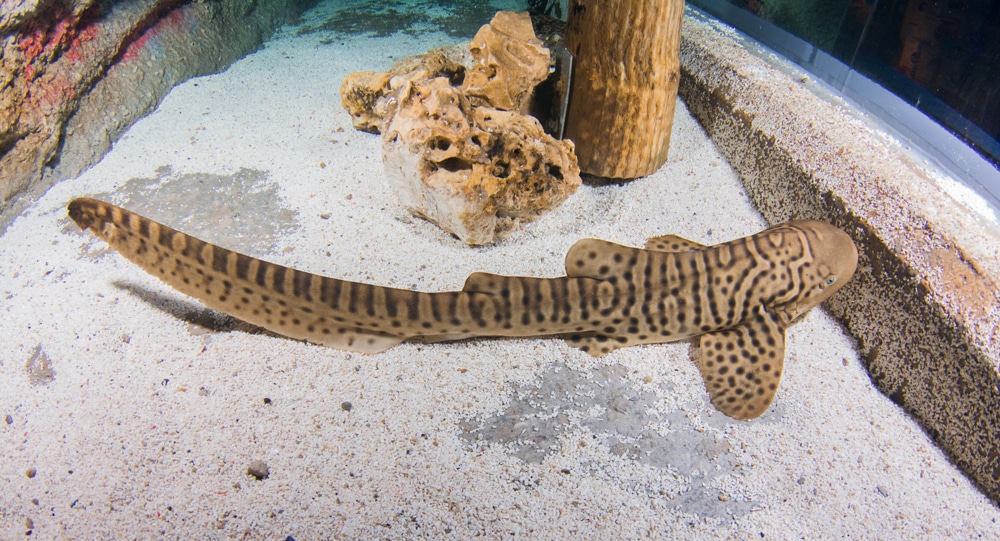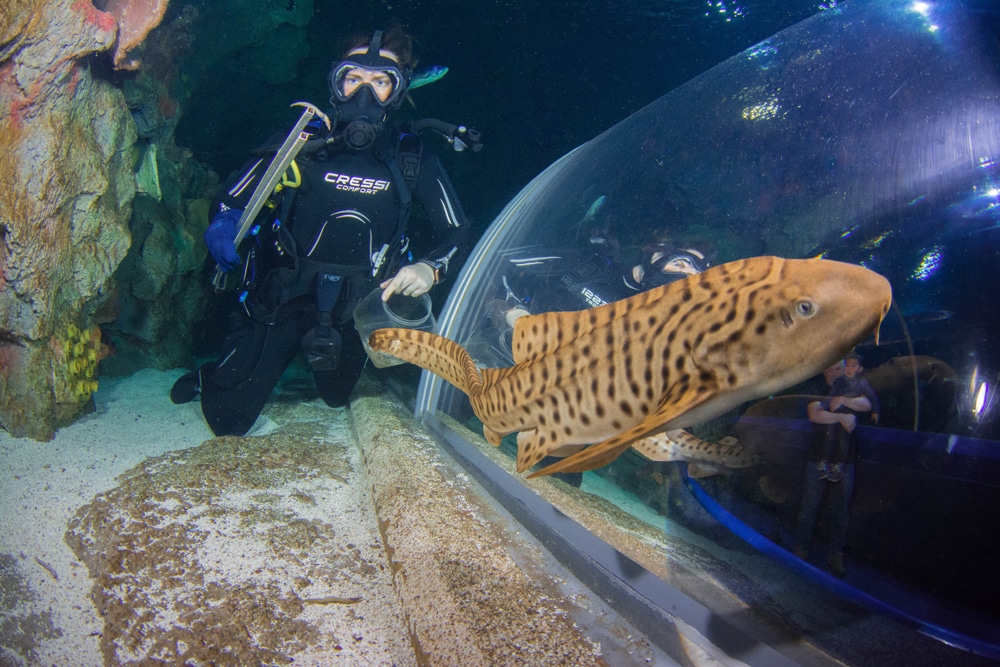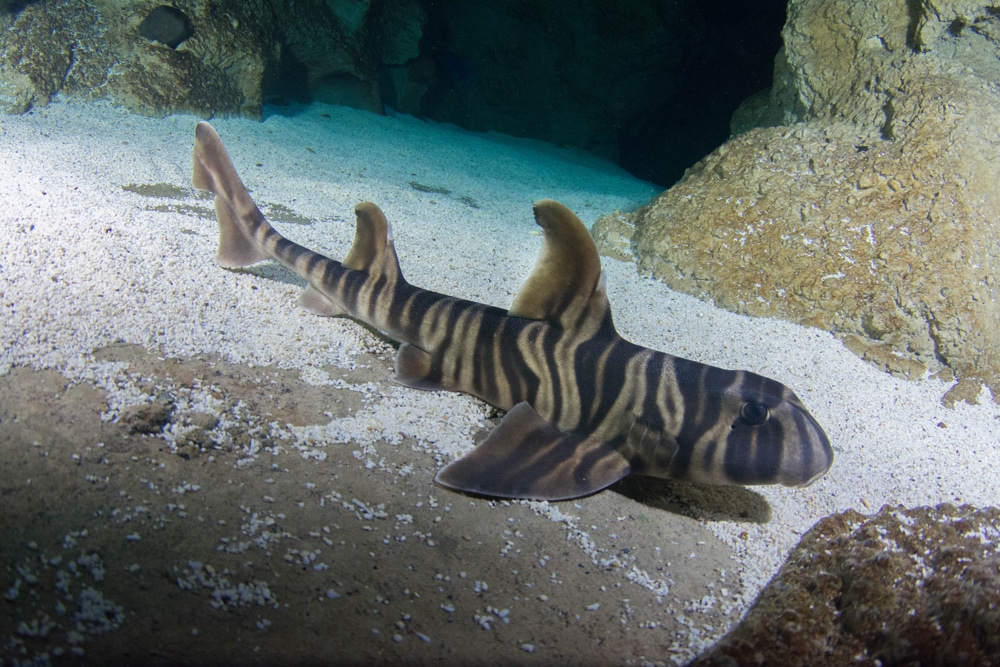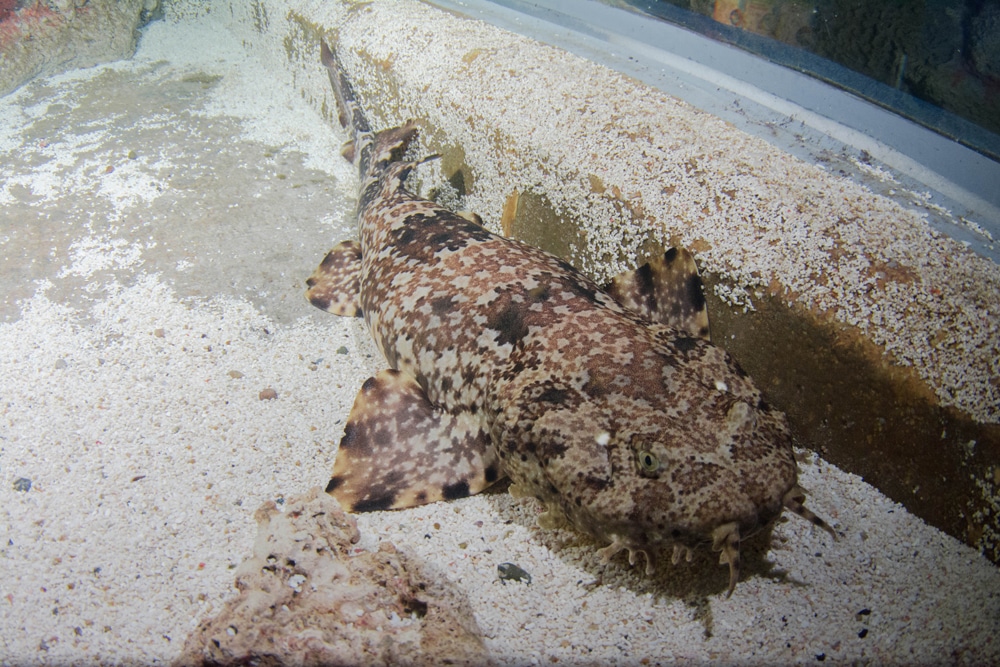Marine Life & Conservation Blogs
New Arrivals at Blue Planet Aquarium

 There’s been exciting times recently here at Blue Planet Aquarium, as we have had some new arrivals. When we get new arrivals its always an exciting time to be working in the Aquarium, however recently we’ve had some truly unique and unusual animals to join the rest of our collection of animals. So, this blog is going to be covering the newest members of the Blue Planet family, and why their uniqueness is so beneficial to our other animals.
There’s been exciting times recently here at Blue Planet Aquarium, as we have had some new arrivals. When we get new arrivals its always an exciting time to be working in the Aquarium, however recently we’ve had some truly unique and unusual animals to join the rest of our collection of animals. So, this blog is going to be covering the newest members of the Blue Planet family, and why their uniqueness is so beneficial to our other animals.
The new animals in question are Sharks with one being from a species we already have at the aquarium and two being completely new to the aquarium. Here at Blue Planet Aquarium we’re constantly trying to educate our visitors and show them new ways to appreciate our underwater world and the animals that we have living on this planet we call home.
So, lets dive straight in (no pun intended).
We’re going to start today with an animal that we already have two of and have had at the aquarium for several years, we have one teenage male named Marty (Named after the zebra from the Madagascar film) and Stripes (Named after Racing Stripes) however this new one is still a very young Shark and is a female who we’ve named Deborah the Zebra.
This species is also a hugely popular species here at Blue Planet and I would probably say are a favourite of mine, I am of course talking about our Zebra Shark. Zebra Sharks are identified by their yellowish- brown colouration with a spotty pattern covering their body, people usually ask at this stage why they’re called Zebra Sharks if they have spots. They’re called Zebra Sharks because when they’re young they’ve got Black & White Stripes all the way down their body, similar to that of a zebra, this species also has the second longest tail in the Shark world after the Thresher Shark.
The long tail combined with their striped pattern makes them look similar to that of the White-banded Sea Snake which has also lead some scientists to believe that this species may mimic the snake to deter predators, if this is the case then this would be the first case of protective mimicry in Sharks. Zebra Sharks are also one of the few Sharks that we know exhibit parthenogenesis which means that this species can lay viable eggs without a male needed, however all the pups born through this process will all be females. Zebra Sharks have also been found to share a very close relation to that of the world’s largest fish, the Whale Shark, we know this as their DNA is very similar and the Zebra Shark shares very similar features.
Our Zebra Sharks are all hand fed and eat a wide variety of foods such as Mackerel, Whiting, Saury, Squid and hard-shelled food such as Razor Clam. They’re incredibly friendly and regularly come in to investigate what’s going on, they’ll often rest against us and seem to show interest in having physical contact with members of the dive team, however we try and limit this as they wouldn’t get it in the wild, although sometimes we have to in order to stop them from trying to steal all the food or keep them at a distance that we can work with.
The next new Shark member is our Zebra Bullhead Shark, this is one of the more unusual Shark species that we have. It’s a member of the of the Horn Shark Family which is the same family of sharks as the Port Jackson Shark, this shark is very striking as it has very obvious Black and White Stripes and even more unusually, a small spike on both the Dorsal fin and Second Dorsal Fin which is where the name “Horn Shark” comes from. In this species early stages of life, they have a very similar striped pattern as their adult stage however their black stripes are more of a reddish-brown.
This species in the wild feeds mainly on hard-shelled foods such as crabs and molluscs however they wouldn’t say no to fish, ours is fed on fish, squid, razor clam and Mussel. Here at Blue Planet Aquarium we have just one Zebra Bullhead and ours is a male, this shark along with the next species I’ll be talking about are not yet named as we are having our guests choose names for us. Zebra Bullheads lay eggs rather than live birth, like mammals, and this group of sharks is a very ancient group with a long fossil record, that date these sharks all the way back to the early Jurassic which was around 201 million years ago.
The last two species are some of my personal favourites, which are known as Wobbegong Sharks. The name Wobbegong comes from the aborigine word for “Shaggy Beard”, this has led to them being lovingly known as “Wobbies” in Australia and among Shark enthusiasts. We have two species of Wobbegong here at Blue Planet Aquarium we have one Western Wobbegong and one Spotted Wobbegong, they both look vastly different in their patterns and markings and are one of the most unique and unusual Shark species.
Wobbegongs are Ambush predators that lie motionless on, or in, the seabed, rocky overhangs, crevices and caves. They wait to allow their camouflage to help them blend in with their surroundings, they do this until fish and other small animals come within striking range for the best chance of a successful hunt. To add success to a hunt it has been observed with the Tasselled Wobbegong, that they take part in active luring behaviour which is something seen in animals such as the Frogfish or Alligator Snapping Turtle. This is done with the Shark wedging itself into a cave or crevice with its head at the entrance and the tail curled over the top of its head, they then wave their tail side to side to mimic another fish, this is done to create the illusion that the cave is safe and free from predators and its then that the Shark strikes, grabbing any fish that comes too close.
Here at Blue Planet we feed ours on Squid, Mackerel, Saury, Sprat, Sand Eel and Prawn and we feed them via long pole. We do this as the strike from a Wobbegong is so quick that the human eye cant register it straight away, this also allows us to mimic hunting behaviour by giving the food a “swimming motion” to it which allows the animals to pick their target and hunt for their food rather than just feeding them.
These sharks are really important to us here at the aquarium as not only are they amazing and beautiful but they’re unusual looks and nature make them a reference point to just how diverse and incredible the Shark family is, sure everyone knows what a Hammerhead and Whale Shark is and as amazing as they are its always humbling to be able to show our guests just how unusual the Shark family can be along with the amazing traits and behaviours that comes along with them.
So, there you have it, some wonderful new arrivals here at Blue Planet Aquarium with each one being as amazing as the last. When you’re next at Blue Planet keep an eye out for these amazing new arrivals and make sure to appreciate just how strange and unique they are. Keep an eye out for future new arrivals and I’ll see you in the next blog.
For more information about Blue Planet Aquarium please visit their website by clicking here.
Blogs
Saba’s Plan for a Coral Comeback

Saba has an exciting new initiative to restore its coral reefs. This new project, running from 2024 to 2026, will focus on reviving key species in the island’s underwater ecosystems. With a collaborative team from the Saba Conservation Foundation (SCF) and Van Hall Larenstein (VHL) University of Applied Sciences, the project aims to restore both corals as well as sea urchins.
This initiative is centered around coral restoration, specifically reviving two essential coral species—staghorn coral (Acropora cervicornis) and elkhorn coral (Acropora palmata). By mapping parent colonies and using a technique known as coral gardening, SCF will create and maintain coral nurseries. These corals will eventually be outplanted at key reef sites around Saba to not only expand the number of coral colonies, but also provide essential fish habitat. The project focusses on installing coral nurseries, training staff with the newest techniques and starting with the restoration of key reef sites.

Reef Cleaners to the Rescue
It’s not just corals getting a makeover—this project also shines a spotlight on the essential role of grazers, particularly sea urchins. VHL is leading the charge on cultivating and restocking two key sea urchin species, West Indian sea egg (Tripneustes) and long-spined sea urchin (Diadema), known for their ability to keep algae in check. By removing algae, which are important competitors of corals, they help the coral to thrive. By restoring these “reef cleaners,” Saba’s project will give corals the breathing room they need to grow, setting the stage for a healthier, more balanced marine ecosystem.
From Tiny Urchins to Big Goals
The project will be funded as part of the Dutch Government’s Nature and Environment Policy Plan (NEPP) 2020-2030 for the Caribbean Netherlands, a comprehensive initiative aimed at conserving and restoring the unique natural environments of the Dutch Caribbean islands, including Saba, St. Eustatius, and Bonaire. This project is aiming for big milestones: build and maintaining coral nurseries, the expansion of urchin cultivation facilities, and the creation of a dedicated research center. By 2026, the project hopes to ramp up coral and grazer restoration, with the ultimate goal of extending these efforts across the Dutch Caribbean. By linking local initiatives to broader regional goals, Saba’s restoration project promises to leave a lasting impact on both the environment and the community.
Find out more about the DCNA at dcnanature.org.
Blogs
Reef-World marks two decades of marine conservation: strengthening impact amid coral reef threats

Empowering ocean stakeholders to tackle future challenges and ensure the survival of coral reefs and humanity
2024 marks the 20th Anniversary of The Reef-World Foundation’s tireless efforts for global coral reef conservation. The UK charity is the international coordinator of the UN Environment Programme’s Green Fins initiative, known as the leading voice in sustainable marine tourism. Today, Reef-World released its 2023-2024 Impact Report outlining a year of substantive growth and impact in its marine conservation programmes.

Impact Report Highlights:
- Impressive improvements in environmental behaviours to protect coral reefs by the marine tourism industry as the global participation of Green Fins increases.
- Continued capacity building for government and NGO staff to effectively manage marine tourism activities in Asia, Caribbean and Red Sea regions.
- For the first time in Green Fins’ 20-year history, tourism operators have achieved ‘Best Environmental Performer’ status by demonstrating the lowest possible environmental impact in their environmental assessments. In 2024, three dive operators achieved this challenging milestone.
- Significant increases in global participation of Reef-World’s innovative digital conservation tools.
- 138 Green Fins dive operator members achieved the strict threshold for PADI Eco Center recognition.
- Developed four new educational materials and translated two into 16 languages to support the marine tourism industry in achieving sustainability targets.
- Establishing a new Reef-World Development strategy and recruiting new roles – Development and Programmes Managers.
- Reef-World’s board welcomes new Chair and Trustees strengthening organisational leadership.

Reef-World started as a one-person mission to inspire and empower communities to act in conserving and sustainably developing coral reefs and related ecosystems. Today, the team of 12 continues to meet this mission by inspiring and empowering the global marine tourism community to be exemplary sustainability leaders by using the Green Fins guidelines and tools to simultaneously use and protect the world’s precious reefs.
In April 2024, the fourth global coral reef bleaching event was confirmed. Reef-World’s work has never been more urgent as the marine environment, and the benefits they provide humanity, continue to be eroded by global threats. The reduction of local threats, like those from the marine tourism industry, is an essential step to ensuring a future where coral reefs survive and continue to support the millions of people who depend on their ecosystem benefits. Reef-World’s work buys time for coral reefs and related ecosystems to be resilient to the impacts of global threats.
“Right now our corals are facing the greatest fight of their existence as the terrifying predictions of the steps towards their complete extinction are starting to come true. But all is not lost, reefs are resilient and they have existed on this planet for millions of years. We must take action now, to buy time for reefs by reducing threats facing them and allowing them to react and adjust to the changing environment they need to survive in.” – Chloe Harvey, Executive Director
Looking Forwards:
Like coral reefs, the Reef-World team needs to be resilient in the face of the complex challenges of the conservation sector. Reef-World has invested significantly in developing a Culture of Care to ensure the well-being of its team on a daily basis, continuing to be an exemplary employer to enable its team to best achieve the mission for coral reef conservation.
With the foundations of a Culture of Care and organisational development laid, Reef-World is emerging from the end of a natural organisation life cycle, that brings the challenges of growth and scale, stronger than ever. With a new strategy in place to generate much needed resources, Reef-World is excited for the opportunities to leap forward, continue to scale our impact and lean into new innovations and untapped opportunities for marine conservation.
We continually strive to become a forward-thinking organisation that delivers on our goals and commitments to our stakeholders with fresh approaches and not being afraid of steering away from a “normal approach.” This approach is not only applied to our programmes of work but also internally and carries over to our Culture of Care for our team.” — JJ Harvey, Operations Director

The Reef-World Foundation is immensely grateful for the continued support of its grant funders: UN Environment Programme, IUCN’s Blue Natural Capital Financing Facility, Adventure Travel Conservation Fund, PADI Aware Foundation, and World Nomads Footprints Program.
Reef-World would also like to express its gratitude to international partners whose vital support has resulted in significant tangible benefits for our work and mission: PADI; Professional SCUBA Schools International (PSS); Explorer Ventures; 1% for the Planet; ZuBlu; Snorkel Venture, GSTC; Dive O’Clock; Seven Dragons; DiveAssure and Eco Beach, without whom these achievements would not be possible.
The full 2023–2024 Annual Impact Report is available on Reef-World’s website.
-

 News2 months ago
News2 months agoIconic SS United States to become the World’s Largest Artificial Reef
-

 News3 months ago
News3 months agoBook Review – 52 Assignments: Underwater Photography
-

 Gear News3 months ago
Gear News3 months agoDYNAMICNORD – New German diving brand enters the British market
-

 News3 months ago
News3 months agoExploring Cenote El Pit: A Diver’s Dream
-

 Gear News3 months ago
Gear News3 months agoTry BARE drysuits (and maybe even win one!) this Friday with Sea & Sea at North West Dive Fest
-

 Marine Life & Conservation3 months ago
Marine Life & Conservation3 months agoBook Review: Coral Triangle Cameos
-

 Blogs2 months ago
Blogs2 months agoDive the Egyptian Red Sea this Autumn with Regaldive
-

 News3 months ago
News3 months ago2024 Ocean Art Underwater Photo Competition Announced


















